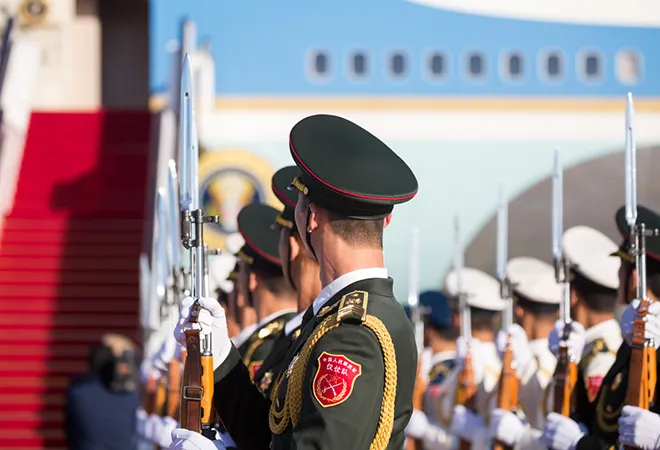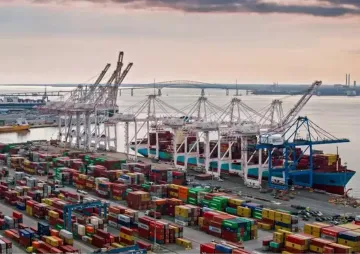The world is teetering on the brink of a trade war between China and the US.
US President Donald Trump fired a new shot in the trade war on Thursday (5 April) when he said he had directed the United States Trade Representative (USTR) to consider an additional $100 billion tariff following China’s decision to retaliate against an earlier $50 billion worth of proposed tariffs.
For the record, Trump tweeted on 4 April, the day the USTR listed the new tariffs on a slew of Chinese goods, “We are not in a trade war with China, because that was lost many years ago…”
An earlier round of tariffs saw the US announce 30% tariffs on imported solar panels and washing machines in January. This was followed by 25% tariff on steel and 10% on aluminium on the grounds of national security, though Mexico and Canada were exempted.
On 22 March, Trump announced that the US would impose tariffs on $50 billion worth of goods. The US targeted industries like aerospace, information and communications technology, robotics and machinery. On the same day, the USTR issued a lengthy report detailing the manner in which China forced American companies to transfer key technology and trade secrets and Chinese proclivity for stealing data through hacking.
On 2 April, China announced tariffs on US goods worth $3 billion on some 130 American products like fruits, nuts, wine and steel pipes, as well as pork and recycled aluminium. On 4 April, following the publication of the list of items that the US would target, China listed products worth $50 billion imported from the US which would now be subject to 25% tariffs, these included soya beans, automobiles and chemicals.
The US imported $505.6 billion worth of goods from China in 2017, of which the largest category were computers and computer accessories ($77.1 billion), mobile phones ($70.3 billion), telecom equipment ($33.5 billion) and toys, games and sports goods ($26.7 billion). The current USTR lists avoid many of these items so as to spare the ordinary consumer the pain of price hikes.
The USTR action, which would cover several thousand separate tariff lines, will be reviewed further after the public notice and comment process, including hearing. It is only after all this happens that the agency will issue a final determination on the list of products that will be subject to the additional tariffs, which could now approximate $150 billion worth of Chinese imports.
There is considerable worry about where this escalation cycle can land up. There are many complexities that escape Trump’s simplistic understanding of the trade deficit issue. Actually, the issue is not just between China and the US. A “Chinese” product comprises elements from other countries.
There is considerable worry about where this escalation cycle can land up. There are many complexities that escape Trump’s simplistic understanding of the trade deficit issue.
The logo on the iPhone notes, “Designed in California, assembled in China”. The iPhone costs Apple $220. It is assembled in China for $6.50, but the rest of the cost is for its sophisticated components made in Germany, South Korea, Japan and the US. In other words, any “trade war” between these two giants will have consequences for many other smaller countries — there will be collateral damage.
The Economist says that 30% of the value of goods that China exports to the US is added elsewhere — Taiwan, Malaysia, Singapore and so on. If the situation worsens, “countries entwined in Chinese supply chains will suffer” and in its estimation, Japanese suppliers could be the worst hit in absolute terms.
As this analysis points out, Chinese value addition has the lowest value addition in the high tech sector. In the case of computers and electronics, “less than half the value added in Chinese exports come from China”. It notes that even while Chinese industrial policies are charged with trying to build up its state-owned enterprises, they account for an increasingly declining share of exports. Anyway, the big worry now is that China’s retaliation could be escalated to cover major firms like GM or Apple, even if Chinese workers are affected by it.
President Xi Jinping is expected to address the Boao Forum next week. In keeping with the Chinese posture, he will put across the country as a victim of American capriciousness and as one which is willing to play by the rules. It is also initiating a complaint in the WTO that the US was in serious violation of global trading rules by targeting Chinese goods for tariffs.
China has already signalled that it is willing to make concessions, such as those related to the opening up of the finance sector. When Trump visited China in November 2017, Beijing offered concessions like raising caps on the foreign ownership of banks and securities firms. Global firms have been cautious here because they would have to use Chinese telecom equipment for their operations and store data there as part of its laws. Chinese vice finance minister Zhu Guangyao had said that the country would allow foreign investors to own 51% of Chinese securities firms, fund managers and futures companies and allow them to own 100% three years later. The current limit on foreign ownership is 25% for large publicly traded securities firms and 49% for most other businesses. He also promised that China would raise the allowed foreign investment in insurance companies which was 50% for most companies to 51% in three years and 100% in five years.
But given the USTR focus, it seems unlikely that they will be willing to accommodate American demands which are increasingly focusing on their industrial policy that comes under the rubric of “Made in China 2025.”
This policy is key in order to modernise the country’s economy, move up the innovation chain and avoid the middle-income trap, which is something most Western economists have been telling China it must do. The Communist Party of China is fully aware of the fact that its power rests on its ability to ensure China’s positive economic trajectory. So it is unlikely to be deterred from its task by the steps taken by the Trump administration at this time.
It is not surprising that the latest round of Trump tariffs got a tough response from Beijing. Chinese authorities declared that they would fight back against US plans at any cost. Official spokespersons of the Ministry of Commerce and Foreign Affairs said that while China did not want a trade war “we are not afraid of it.”
This commentary originally appeared in The Wire.
The views expressed above belong to the author(s). ORF research and analyses now available on Telegram! Click here to access our curated content — blogs, longforms and interviews.




 PREV
PREV


